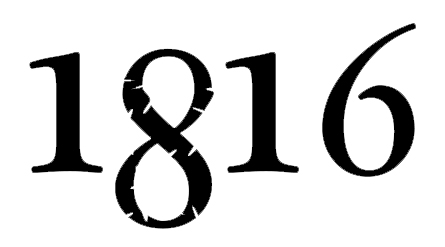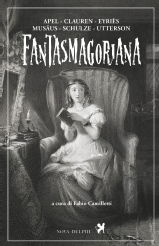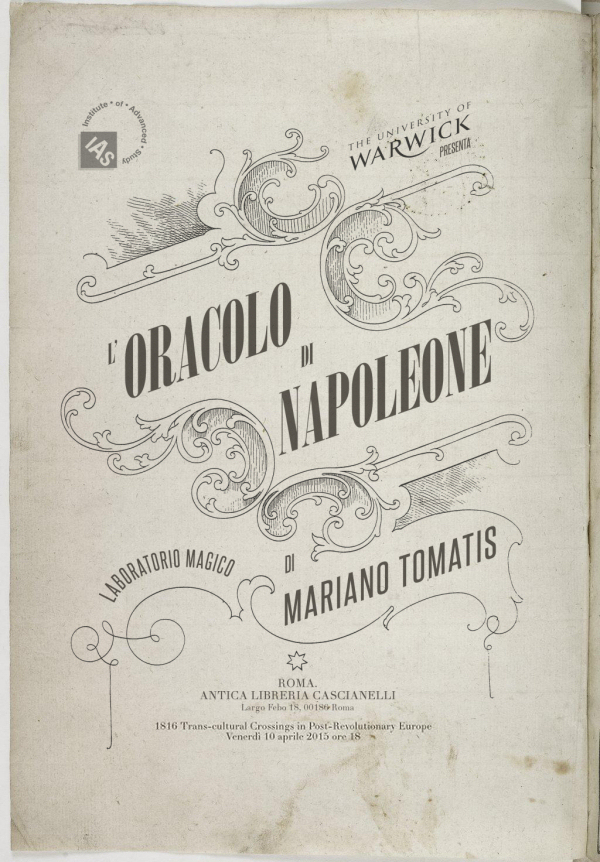Trans-cultural Crossings in Post-Revolutionary Europe

In 1816, one year after Waterloo and the Congress of Vienna and in the midst of the so-called ‘Year Without a Summer’, Benjamin Constant publishes Adolphe, a novel portraying a paradigmatic example of Romantic (or post-revolutionary) hero; Byron travels on the continent and composes the third canto of Childe Harold, including a meditation on the Waterloo battlefield, and in June, in his house in Geneva, he welcomes Mary and Percy Shelley, who has already published Alastor and is about to compose Mont Blanc: they read German ghost stories translated into French, and decide to write supernatural tales on their own, a game that will give birth to Mary Shelley’s Frankenstein, Polidori’s The Vampyre, and to the fragment later published by Byron as an appendix to Mazeppa; a few months before, Coleridge had given to press the unfinished poems Kubla Khan and Christabel. In Germany, there appear E.T.A. Hoffmann’s Nachtstücke [Night-Pieces] and the first volume of Goethe’s Italienische Reise [Italian Journey]; in Spain, Goya accomplishes Los desastres de la guerra [The Disasters of the War], paints his Casa de locos [The Madhouse], and publishes the prints entitled Tauromaquia [Bullfighting]. In Italy, 1816 marks the beginning of the so-called Classicist/Romantic quarrel, heralded by a famous article by Madame de Staël; Ugo Foscolo prepares the fourth edition of Jacopo Ortis, Giacomo Leopardi attempts to gain public visibility by writing a letter to the Milanese periodical Biblioteca italiana, and Alessandro Manzoni, inspired by a French translation of A.W. Schlegel’s lectures on theatre, begins to work on his tragedy Il Conte di Carmagnola [The Earl of Carmagnola].
Many of these works, it has been argued, variously deal with the legacies of the French revolution and of the Napoleonic wars, not only as far as they explicitly raise the themes of war, tyranny, ambition, and political legitimacy – as happens with Childe Harold, Jacopo Ortis, Manzoni’s Carmagnola, or Goya’s Desastres – but also because they implicitly or surreptitiously question the problem of modernity and its relationship with tradition: whereas the Classicist/Romantic quarrel transfers the post-revolutionary erosion of political authority into a global question on the decay of literary authorship (and Coleridge’s preface to Kubla Khan, on the other side of the Channel, delineates an ideal of poetic composition in which the author is no longer ‘master in his own house’), such works as those of Hoffmann or Goya explore the twilight zone between folly and normativity and illusion and disenchantment, left as a legacy by the Enlightenment and its attempt (in Leopardi’s words) at ‘geometrizing’ the entire human experience. First and foremost, composed and published, as they are, in the politically fluid moment between the battle of Waterloo and the raise of nineteenth-century nationalisms, these works stem from a quintessentially trans-national and trans-cultural milieu. Byron’s, Shelley’s, and Goethe’s works turn eighteenth-century travel writing into new modalities of confrontation with otherness; the Classicist/Romantic quarrel displays a constitutive tension between ‘Meridionist’ perceptions of Italy (as those of Madame de Staël or Byron) and the self-perception of Italian culture on the part of pre-Risorgimento élites; in Villa Diodati, Byron, the Shelleys and Polidori read Fantasmagoriana, a French anthology of German ghost stories; Hoffmann’s collection includes tales taking place in Italy and medieval Spain, and is moreover deeply influenced by Italian baroque music; Manzoni’s tragedy is inspired by a German work translated into French; Polidori travels to Milan, where he meets the protagonists of the Classicist/Romantic quarrel and comes plausibly in touch with Berchet’s work on German Sturm und Drang poetry.
By taking 1816 as a symbolic year and, at the same time, as an object of study, our project aims to go beyond definitions such as those of ‘Classicism’ and ‘Romanticism’ in order to analyse post-revolutionary European culture as a global phenomenon, characterised by trans-national crossings, contacts, and reciprocal influences. Stemming from the research work that is currently carried on in eighteenth- and nineteenth-century studies within the School of Modern Languages and Cultures, and funded by the Global Research Priorities 'Connecting Cultures' scheme, our project seeks to find new ways of confrontation between nineteenth-century scholars within and beyond the School, with the aim of paving the ground for a broader and more substantial collaborative research work.
Logo by Giacomo Mannironi

Workshops
27 February 2015 TO BE RESCHEDULED
12 March 2015
The Novel in 1816: Post-Revolutionary Heroism and Modernity
Guest speaker Patrick O'Donovan (UCD)
Location tbc
10 April 2015, Rome
Illusione, inganno, artificio: Coleridge, Hoffmann, Manzoni, Leopardi 
In collaboration with Laboratorio Leopardi (University of Rome La Sapienza)
(University of Rome La Sapienza)
followed by
L'Oracolo di Napoleone . Magical Laboratory by Mariano Tomatis
. Magical Laboratory by Mariano Tomatis
In collaboration with Antica Libreria Cascianelli, funded by the IAS
15 May 2015
Phantasmagoria between Visuality and Textuality (working title)
Guest speaker Rupert Gaderer (Ruhr-Universität Bochum)
IAS Seminar Room (Millburn House)
Outcomes
Jean-Baptiste Benoît Eyriès et al., Fantasmagoriana, ed. & transl. by Fabio Camilletti (Rome: Nova Delphi, forthcoming April 2015)

Mariano Tomatis, L'oracolo di Napoleone. Magic laboratory, 10 April 2015. Audio podcast and free downloads here


